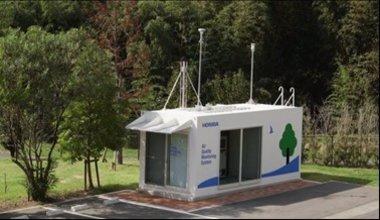Existing AQMS*1 models are designed to measure NOx, SO2, O3, HC, and PM10/2.5, among others, which are subject to air quality regulations. The latest addition to the AP-370 series, the APCA-370 is also capable of measuring CO2, which is currently not regulated, in addition to the types of air pollutants above.
Recent years have seen an increase in the need to measure atmospheric CO2 in Europe and elsewhere as its control holds the key to reducing greenhouse gas emissions in accord with the Paris Agreement. In order to meet other emerging needs, such as enhanced monitoring of greenhouse gases, monitoring of CO2 concentrations in the indoor environment, and leakage detection of CO2 during the collection/storage processes, the APCA-370 uses HORIBA’s proprietary measurement technology, the “cross-flow modulation non-dispersive infrared (NDIR) analysis method*2” to realize the “self-regenerating CO2 absorption function*3,” thus achieving highly precise measurements with long-term stability.
HORIBA will remain committed to utilizing its measurement and analysis technologies to contribute to the establishment of an environmental preservation system.
<About the APCA-370>
HORIBA has realized measurement that is highly precise and stable over the long term by applying its proprietary cross-flow modulation NDIR analysis method to CO2 measurement without using operation gas from outside. This was enabled by building a zero-point adjustment standard gas (“zero gas”) supply unit with the self-regenerating CO2 absorption function into the monitor.
<Background of development>
Much attention is being paid to monitoring ambient CO2 concentrations as we seek to reduce greenhouse gas emissions in compliance with the Paris Agreement. This is particularly true in Europe, where the monitoring need is increasing each passing year. In order to elucidate how CO2 circulates on a global scale, attempts are being made to observe background CO2 levels in areas with little anthropogenic emissions. In Japan, the Meteorological Agency discloses data that it collects in Ryōri Village (Iwate Prefecture), Minami-Tori-shima Island (Ogasawara Village, Tokyo), and Yonaguni-jima Island (Okinawa Prefecture). In 2017 , CO2 concentrations have increased by 46% from 278 ppm*4, which is what is believed to have been the average in the pre-Industrial Revolution days (around 1750), to surpass 400 ppm.
Ref.: The Japan Meteorological Agency website
www.data.jma.go.jp/ghg/kanshi/ghgp/co2_e.html
Some power stations have begun working on technologies to capture emitted CO2 and put it to effective use in what could be a key for reducing CO2 emissions to virtually zero. To do so requires the ability to detect leakage of CO2 thus captured. Given such a backdrop and need in the market, we developed the APCA-370 for CO2 measurement.
<Specifications>
Product name: APCA-370 Ambient Carbon Dioxide Monitor
Dimensions/Mass (for the analyzer unit): 430 (W) x 550 (D) x 221 (H) mm / Approx. 20 kg
Application: CO2
<Terminology>
*1 AQMS (Air Quality Monitoring System): A system that comes with a continuous monitor capable of measuring metrological parameters for a year, including the direction and speed of wind, and concentrations of ambient parameters, such as sulfur dioxide, particulate matter, nitrogen oxide, carbon monoxide, and ozone
*2 Cross-flow modulation method: A method that measures gas and “zero gas” samples alternatively by using the same cell to minimize differences in measurements that may arise otherwise
*3 Self-regenerating CO2 absorption function: A function that absorbs CO2 from the atmosphere for purification. The “zero gas” supply unit has two purification cylinders. When one purification cylinder is in use, the other purification cylinder is regenerated. By switching between use and regeneration on a fixed time cycle, continuous purification is made possible.
*4 ppm: A value that represents the concentration of a designated substance within every one million molecules in the atmosphere

